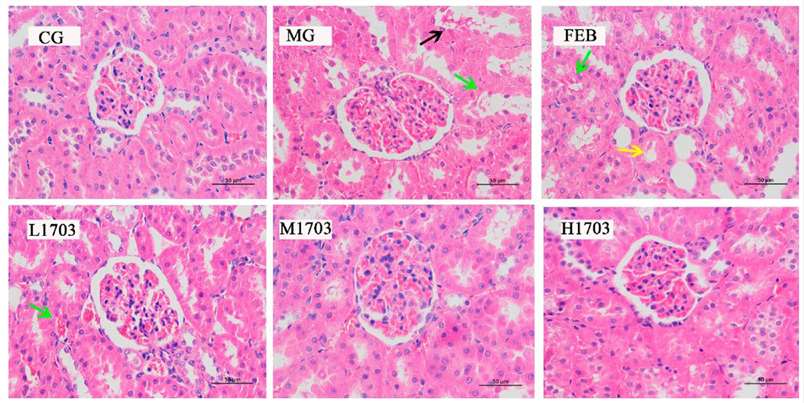Yeast Extract and Potassium Oxonate-Induced Hyperuricemia Model
Creative Bioarray offers a hyperuricemia model induced by yeast extract and potassium oxonate to meet the unique requirements of our clients. With our extensive expertise, our scientists are prepared to develop a comprehensive research plan specifically tailored to your needs. Furthermore, we provide services to evaluate the efficacy of your drug candidates.
Yeast extract, abundant in nucleic acids and proteins, has the potential to heighten the activity of xanthine oxidase (XOD). This increase in XOD activity leads to an amplified production of uric acid, consequently disrupting the normal purine metabolism process. In conjunction, potassium oxonate, classified as a triazabenzene compound, exerts its influence by suppressing the activity of uricase. This suppression further contributes to the escalation of uric acid levels within the body. The synergistic effect of yeast extract and potassium oxonate in inducing a model of hyperuricemia closely emulates the condition triggered by a high-purine diet in humans. This carefully designed model not only serves as a critical platform for assessing the effectiveness of various therapeutic interventions against hyperuricemia but also plays a pivotal role in unraveling the complex mechanisms that underpin this prevalent human condition.
Our Yeast Extract and Potassium Oxonate-Induced Hyperuricemia Model
- Available Animal
Rat
- Modeling Method
Animals are fed a daily regimen of yeast extract diet combined with intragastric potassium oxonate for 4 weeks to induce hyperuricemia.
 Fig. 1 Modeling method of yeast extract and potassium oxonate-induced hyperuricemia model.
Fig. 1 Modeling method of yeast extract and potassium oxonate-induced hyperuricemia model.
- Endpoints
- Serum biomarkers: uric acid (UA), creatinine, BUN, etc
- Kidney observation
- Histology analysis of kidney: H&E staining, Masson staining
- qPCR or Western blot
- Body weight
- Other customized endpoints: available upon request
Example Data
 Fig. 2 Pathological changes in the renal tissue of six groups rats at experiment termination after YEP-potassium oxonate-induced hyperuricemia. (Li et al. 2022)
Fig. 2 Pathological changes in the renal tissue of six groups rats at experiment termination after YEP-potassium oxonate-induced hyperuricemia. (Li et al. 2022)
Quotation and Ordering
If you are interested in our hyperuricemia models, please feel free to contact us at any time or submit an inquiry to us directly. Our scientists are pleased to tailor the best-fit proposal to meet your demands.
References
- Zhu, Y., et al. An update on the animal models in hyperuricaemia research. Clin Exp Rheumatol, 2017, 35(5): 860-864.
- Li, Y., et al. Pharmacodynamic evaluation of the XOR inhibitor WN1703 in a model of chronic hyperuricemia in rats induced by yeast extract combined with potassium oxonate. Current Research in Pharmacology and Drug Discovery, 2022, 3: 100098.
For research use only. Not for any other purpose.
Disease Models
- Oncology Models
-
Inflammation & Autoimmune Disease Models
- Rheumatoid Arthritis Models
- Glomerulonephritis Models
- Multiple Sclerosis (MS) Models
- Ocular Inflammation Models
- Sjögren's Syndrome Model
- LPS-induced Acute Lung Injury Model
- Peritonitis Models
- Passive Cutaneous Anaphylaxis Model
- Delayed-Type Hypersensitivity (DTH) Models
- Inflammatory Bowel Disease Models
- Systemic Lupus Erythematosus Animal Models
- Oral Mucositis Model
- Asthma Model
- Sepsis Model
- Psoriasis Model
- Atopic Dermatitis (AD) Model
- Scleroderma Model
- Gouty Arthritis Model
- Carrageenan-Induced Air Pouch Synovitis Model
- Carrageenan-Induced Paw Edema Model
- Experimental Autoimmune Myasthenia Gravis (EAMG) Model
- Graft-versus-host Disease (GvHD) Models
-
Cardiovascular Disease Models
- Surgical Models
- Animal Models of Hypertension
- Venous Thrombosis Model
- Atherosclerosis model
- Cardiac Arrhythmia Model
- Hyperlipoidemia Model
- Doxorubicin-induced Heart Failure Model
- Isoproterenol-induced Heart Failure Model
- Arterial Thrombosis Model
- Pulmonary Arterial Hypertension (PAH) Models
- Heart Failure with Preserved Ejection Fraction (HFpEF) Model
-
Neurological Disease Models
- Alzheimer's Disease Modeling and Assays
- Seizure Models
- Parkinson's Disease Models
- Ischemic Stroke Models
- Acute Spinal Cord Injury (ASCI) Model
- Traumatic Brain Injury (TBI) Model
- Hypoxic-Ischemic Encephalopathy (HIE) Model
- Tourette Syndrome (TS) Model
- Amyotrophic Lateral Sclerosis (ALS) Model
- Huntington's Disease (HD) Model
- Intracerebral hemorrhage (ICH) Models
- Schizophrenia Model
- Pain Models
-
Metabolic Disease Models
- Type 1 Diabetes Mellitus Model
- Type 2 Diabetes Mellitus Model
- Animal Model of Hyperuricemia
-
Nonalcoholic Fatty Liver Disease Model
- High-Fat Diet-Induced Nonalcoholic Fatty Liver Disease (NAFLD) Model
- Methionine and Choline Deficient (MCD) Diet-Induced Nonalcoholic Fatty Liver Disease (NAFLD) Model
- Gubra-Amylin NASH (GAN) Diet-Induced Nonalcoholic Fatty Liver Disease (NAFLD) Model
- Streptozotocin (STZ) Induced Nonalcoholic Fatty Liver Disease (NAFLD) Model
- High Fat Diet-Induced Obesity Model
- Diabetic Foot Ulcer (DFU) Model
- Liver Disease Models
- Rare Disease Models
- Respiratory Disease Models
- Digestive Disease Models
-
Urology Disease Models
- Cisplatin-induced Nephrotoxicity Model
- Unilateral Ureteral Obstruction Model
- 5/6 Nephrectomy Model
- Renal Ischemia-Reperfusion Injury (RIRI) Model
- Diabetic Nephropathy (DN) Models
- Passive Heymann Nephritis (PHN) Model
- Adenine-Induced Chronic Kidney Disease (CKD) Model
- Kidney Stone Model
- Doxorubicin-Induced Nephropathy Model
- Orthotopic Kidney Transplantation Model
- Orthopedic Disease Models
- Ocular Disease Models
- Skin Disease Models
- Infectious Disease Models
- Otology Disease Models